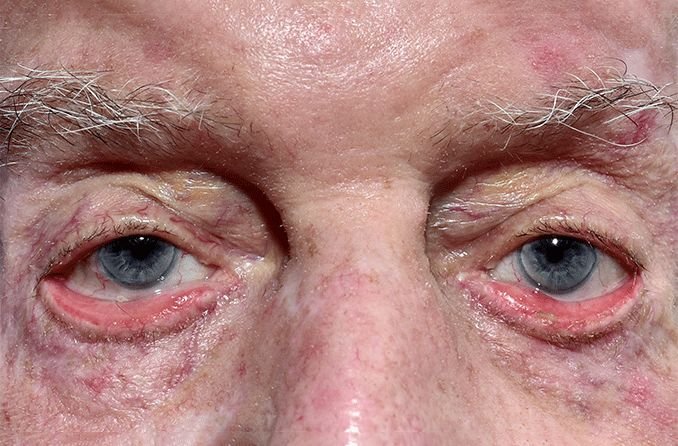Eyelid Surgery
Whether your eyelids are heavy, droopy, saggy, turning in or out, we’d be happy to fix them! Our doctors specialise in oculoplastic (eyelid) surgery, including removal of skin cancers on the eyelids.
Ectropion Eyelid
Ectropion (saggy, outward facing lower lid) is when the lower eyelid turns outwards so that the edge of the lid flops away from the eyeball. The lining of the lower eyelid may become red and swollen due to exposure to the there and there may be mucous discharge and crusting of the lids. The affected eye may become watery because the tear drainage tube in the lid is no longer in the right position to collect the tears.
What are the signs and symptoms?
The most obvious sign of an ectropion is a saggy, outward facing lower lid. From this the lower lid may look red and swollen. Patients may complain of an irritated, gritty/sandy feeling, burning sensation, mucous build-up and/or excessive tearing.
What is the treatment for ectropion?
Artificial tear eye drops and ointments to lubricate the eye can temporarily relieve the symptoms of an ectropion; however, eyelid surgery to tighten the lower lid is usually necessary to fully correct this problem. There are a few different surgical approaches available and your ophthalmologist will discuss the best option for you at your consultation.
Entropion Eyelid
Entropion refers to an inward turning of the lower eyelid. It causes the eyelashes and lid skin to rub against the surface of the eye, causing discomfort. If left untreated it can lead to the ulceration of the surface of the eye, followed by scarring which could cause loss of vision.
What are the signs and symptoms?
The most obvious sign of an entropion is an inward turning lower lid. Patients may experience irritation and pain on the front of the eye, excessive tearing, burning sensation and a red eye. Lower lid entropion is usually due to aging changes in the eyelid making it lax (loose) and prone to flipping inwards. To begin with, the entropion can be present intermittently, but it often progresses later on. Entropion can also be caused by infection (e.g. trachoma), disease or injury.
What is the treatment for Entropion?
Artificial tears may temporarily relieve the irritation from an entropion; however, eyelid surgery to stiffen the lower lid and pull it outwards is usually necessary to fully correct this problem. At Gold Coast Eye Hospital we have surgical approaches available that your ophthalmologist will discuss with you at your consultation.
Ptosis (Droopy Eyelid)
Ptosis (“toe-sis”) refers to drooping of an upper eyelid of one of both eyes. This is different to the excess skin on the eyelid which may give similar appearance. The droop may be barely noticeable, or the lid can drop down over the entire pupil often restricting the field of vision.
Some people with a ptosis try to tilt their heads back to try and see under the lid or raise their eyebrows repeatedly to try and lift the eyelids. This can often cause a headache due to muscle fatigue, as well as forehead wrinkles.
What are the causes?
Ptosis is commonly caused by ageing. As you become older, the levator “lifting” muscles of the eyelid become stretched resulting in the upper eyelid becoming droopy. Ptosis can also be present at birth (congenital ptosis) and some neurological conditions or other systemic diseases can lead to the development of ptosis.
What is the treatment for Ptosis?
Mild ptosis that is not causing problems, either with function or appearance may not require treatment. Eyelid surgery is required for people wishing to fix their ptosis. This procedure is known as a Blepharoplasty. Your ophthalmologist will tighten the levator muscles to lift the eyelids, giving you improved vision and appearance. Our aim is to eliminate the ptosis and give you a natural look that restores your appearance.






